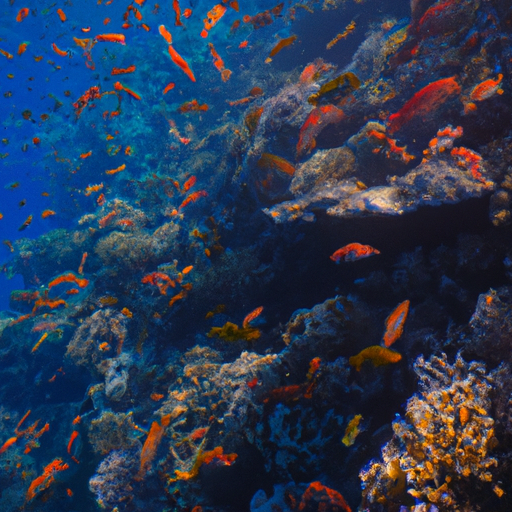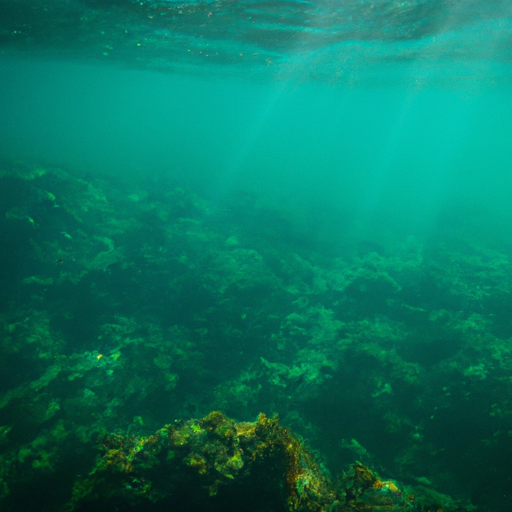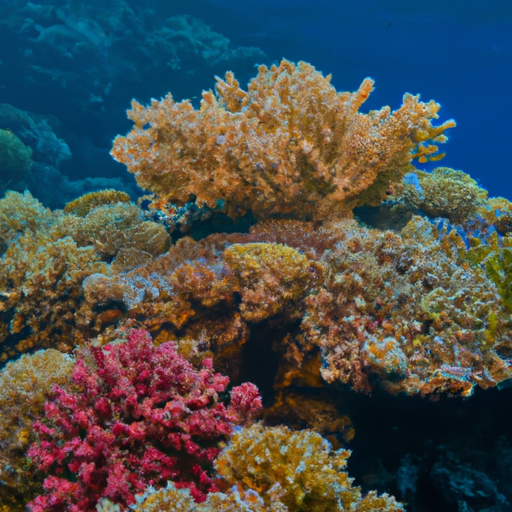
Diving into the Deep: Exploring the Hidden Treasures of the Ocean
The underwater world is a mesmerizing and diverse realm, teeming with an incredible array of marine life. From vibrant coral reefs to mysterious deep-sea creatures, the ocean holds a wealth of wonders waiting to be explored. Diving into the deep allows us to witness the fascinating and often surprising behaviors of marine creatures, offering a glimpse into a world that is both alien and captivating.
One of the most remarkable aspects of marine life is its incredible diversity. The ocean is home to a staggering number of species, many of which have yet to be discovered and studied. From tiny microorganisms to massive creatures like whales and sharks, the range of life forms found in the ocean is truly awe-inspiring. Each species has its own unique characteristics, adaptations, and survival strategies, making the study of marine life a never-ending source of fascination.
Coral reefs, often referred to as the “rainforests of the sea,” are among the most biodiverse ecosystems on the planet. These underwater structures provide shelter, food, and breeding grounds for an astonishing variety of species. From colorful fish darting between coral branches to graceful sea turtles gliding through the water, coral reefs are a bustling hub of activity and a visual feast for divers and underwater photographers.
Exploring the deeper parts of the ocean reveals an entirely different world, where light is scarce and the pressure is intense. In these extreme conditions, creatures have evolved unique adaptations to survive. Deep-sea organisms, such as anglerfish with their bioluminescent lures and giant squid with their colossal size, possess a certain mystique that captures the imagination. Scientists continue to discover new and strange species in the deep sea, further adding to our understanding of this fascinating realm.
Aside from their sheer beauty and diversity, marine organisms also play a vital role in maintaining the balance of our planet’s ecosystems. Phytoplankton, for example, are tiny plants that inhabit the sunlit surface waters of the ocean and are responsible for producing a significant portion of the oxygen we breathe. Additionally, marine creatures serve as a crucial food source for many coastal communities and contribute to the income generated by tourism activities such as snorkeling and scuba diving.
Exploring the wonders of marine life not only broadens our knowledge of the natural world but also fosters a deep appreciation for the delicate balance that exists within our oceans. As we dive into the deep and discover the hidden treasures of the ocean, we are reminded of the importance of preserving and protecting this extraordinary ecosystem for future generations to come.
From Coral Reefs to Deep Sea Trenches: Unveiling the Diverse Ecosystems of the Marine World
The ocean is a vast and wondrous world, teeming with life that often remains unseen to human eyes. From the vibrant colors of coral reefs to the mysterious depths of deep sea trenches, the marine world is a treasure trove of fascinating ecosystems and creatures.
Coral reefs are among the most biodiverse habitats on the planet, hosting a myriad of species. These intricate underwater structures are made up of the calcium carbonate skeletons of tiny animals called coral polyps. Coral reefs provide shelter, food, and breeding grounds for a vast array of marine organisms, including fish, crustaceans, and mollusks. They are home to colorful tropical fish like clownfish, angelfish, and parrotfish, as well as majestic creatures like sea turtles and manta rays.
Beyond the coral reefs, the open ocean is a vast expanse that covers over 70% of the Earth’s surface. This immense body of water is home to an incredible variety of marine life, ranging from microscopic plankton to massive whales. Plankton, including phytoplankton and zooplankton, form the base of the marine food chain and play a crucial role in the global carbon cycle.
The pelagic zone, or the open water of the ocean, is inhabited by numerous species of fish, dolphins, sharks, and whales. These animals have adapted to life in the vast expanses of water, using their streamlined bodies and powerful fins or flukes for efficient swimming. Some of the most remarkable inhabitants of the pelagic zone are the large migratory species, such as blue whales, which can reach lengths of up to 100 feet and weigh over 200 tons.
Descending into the depths of the ocean, we encounter a completely different world. The deep sea trenches, some of the most mysterious and least explored areas on Earth, harbor a unique and otherworldly ecosystem. Adapted to extreme conditions such as complete darkness, intense pressure, and scarce food, deep-sea creatures have evolved fascinating adaptations. From anglerfish with their bioluminescent lure to deep-sea octopuses with their exceptional camouflage abilities, these creatures have captivated the curiosity of scientists and explorers.
Exploring the wonders of the ocean and its diverse ecosystems brings to light the incredible beauty and complexity of marine life. From the colorful reefs to the enigmatic deep sea, each corner of the marine world holds its own marvels waiting to be unveiled. Understanding and protecting these fragile ecosystems is essential for the preservation of our planet and the countless species that call the ocean home.
Marine Marvels: Unraveling the Extraordinary Adaptations of Sea Creatures
The fascinating world of marine life is a mesmerizing realm filled with an incredible array of awe-inspiring creatures. From the smallest microscopic organisms to the largest mammals on Earth, the diversity and adaptations of sea creatures never cease to amaze us.
One of the most captivating aspects of marine life is the astounding variety of adaptations that these organisms have developed over millions of years. These adaptations allow them to survive and thrive in the challenging and constantly changing marine environment.
Take, for example, the vibrant and delicate coral reefs. These intricate structures are the result of the remarkable relationship between corals and tiny photosynthetic organisms called zooxanthellae. The corals provide protection and a source of nutrients for the zooxanthellae, while the zooxanthellae, in return, provide the corals with energy through photosynthesis. This symbiotic relationship is crucial for the existence of coral reefs and the countless marine species that rely on them for shelter and food.
Another fascinating adaptation is found in the deep-sea creatures that inhabit the dark and extreme depths of the ocean. In these inhospitable conditions, where sunlight doesn’t penetrate and pressures can reach mind-boggling levels, these organisms have developed ingenious adaptations. Some deep-sea fish have evolved large, sensitive eyes to detect the faintest traces of light, while others produce their own bioluminescent light to attract prey or communicate with mates.
Marine mammals also showcase extraordinary adaptations. Take, for instance, the incredible diving abilities of whales and dolphins. These majestic creatures have adapted to survive in both the vast open ocean and the deepest depths. Their lungs and circulatory systems allow them to hold their breath for extended periods, while specialized structures in their body help to regulate the buildup of nitrogen during deep dives.
The incredible adaptations seen in sea creatures offer us a glimpse into the resilience and ingenuity of life. They remind us of the remarkable diversity of the natural world and inspire us to learn more about the complexities of the ocean and its inhabitants.
Exploring the wonders of the ocean and unraveling the extraordinary adaptations of marine life is not only a captivating scientific pursuit but also a critical endeavor. By understanding these adaptations, we can further our knowledge of biology, ecology, and conservation. It is through this understanding that we can appreciate the true marvels of the marine world and work towards its preservation for future generations.
Conservation Challenges: Protecting the Fragile Beauty of Marine Life
The fascinating world of marine life is a treasure trove of wonders waiting to be explored. From the vibrant coral reefs to the mysterious depths of the ocean, the diversity and beauty of marine species never fail to captivate our imagination. However, this fragile beauty is facing numerous conservation challenges that threaten its existence.
One of the key challenges in protecting marine life is overfishing. With the increasing demand for seafood, many fish populations are being depleted at an alarming rate. Overfishing disrupts the delicate balance of marine ecosystems, leading to the decline of certain species and the disruption of food chains. It is crucial to establish sustainable fishing practices and enforce strict fishing regulations to ensure the long-term survival of marine life.
Another pressing challenge is the degradation of marine habitats. Pollution, climate change, and habitat destruction are all factors contributing to the loss of critical habitats for marine species. Oil spills and plastic pollution have devastating effects on marine life, causing injuries, illnesses, and even death. Rising ocean temperatures and ocean acidification due to climate change further endanger the delicate ecosystems that support marine life. Efforts must be made to reduce pollution, mitigate climate change impacts, and restore degraded habitats to protect the fragile beauty of marine life.
In addition to these challenges, the illegal wildlife trade poses a significant threat to marine species. Marine animals such as sea turtles, seahorses, and certain types of fish are often captured and sold illegally for their meat, shells, or as exotic pets. This illegal trade not only threatens the survival of these species but also disrupts the balance of marine ecosystems. Strict laws and enforcement, along with public awareness campaigns, are necessary to combat this illegal activity and protect the fascinating marine life.
Conservation organizations, governments, and the general public all have crucial roles to play in protecting the fragile beauty of marine life. It is essential to support and engage in sustainable fishing practices, advocate for the reduction of pollution, and raise awareness about the importance of marine conservation. By working together, we can ensure that future generations will continue to marvel at the wonders of the ocean and its incredible marine life.


